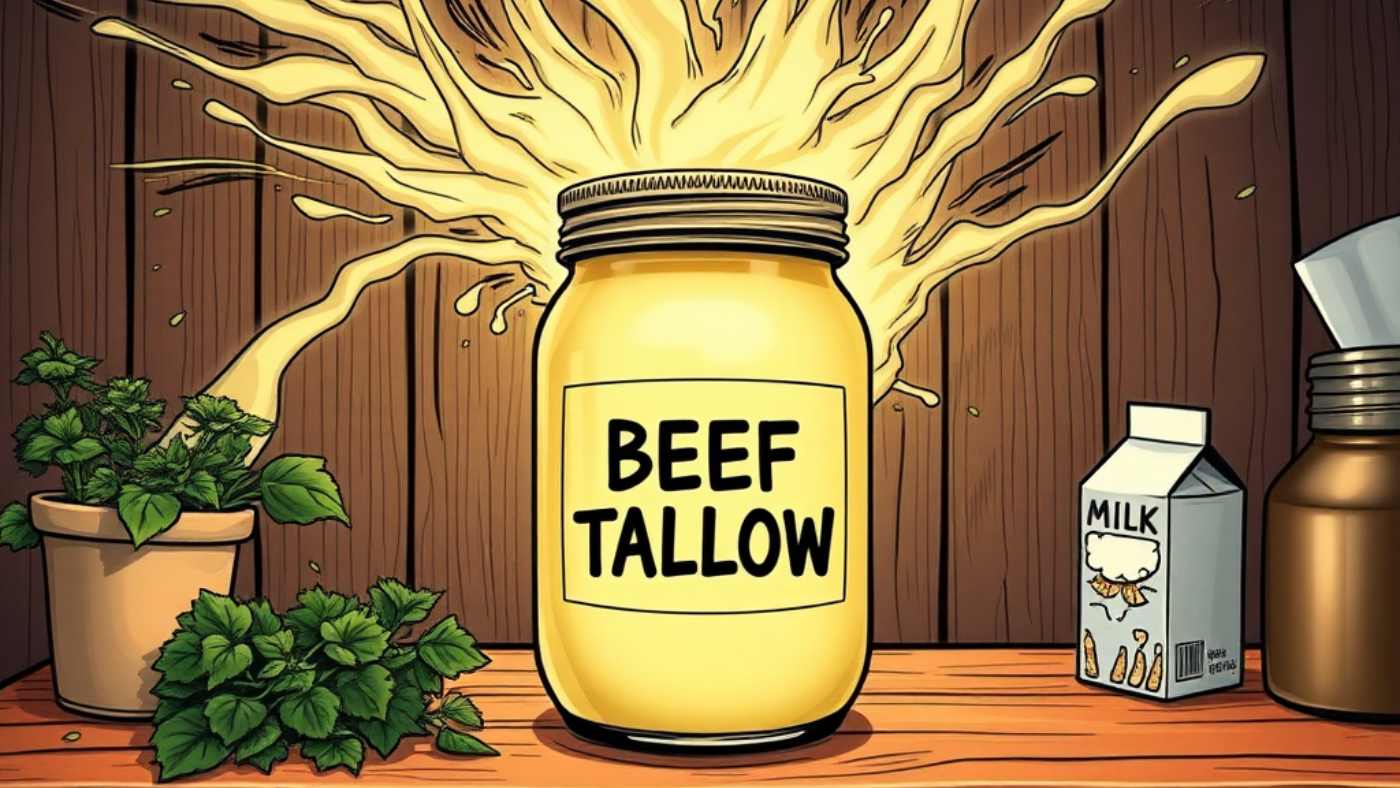Refrigerating Tallow? You Might Be Wasting Its Greatest Superpower

Beef tallow is back in the spotlight.
Chefs are raving. Skincare fanatics are obsessed. Ancestral health bloggers are calling it liquid gold.
But as more people return to traditional fats, one question keeps bubbling up:
Can you leave beef tallow out on the counter — or will it spoil?
It sounds like a simple yes-or-no kind of question, right?
But ask five people, and you’ll get five very different answers.
Some will warn, “Absolutely not — it’ll go bad!”
Others will shrug and say, “Please.
That’s how our ancestors fed entire families without a fridge.” So, who’s right?
Let’s break it down — the myths, the science, and the old-school common sense behind storing beef tallow at room temperature.
Whether you’re slathering it on your skin, cooking up steak, or whipping DIY balm in your kitchen, how you store your tallow matters more than you might think.
What Is Beef Tallow, Really?
At its core, beef tallow is just rendered beef fat.
It’s what you get when you slowly melt down the fatty parts of a cow (usually suet), strain out impurities, and cool the liquid into a smooth, shelf-stable fat.
Tallow has been used for centuries — in cooking, candle-making, skin remedies, and even as fuel.
But in today’s world of refrigeration and expiration dates, its old-school durability tends to raise eyebrows.
Especially when people claim it can sit on your kitchen counter — for months. Is that really safe?

Why Would You Store Beef Tallow at Room Temperature?
First, let’s acknowledge the benefits of keeping tallow at room temp:
- It stays soft and scoopable
- It doesn’t require fridge space
- It’s easy to access for daily use (both cooking and skincare)
- It harks back to pre-refrigeration traditions
But convenience isn’t everything.
The real question is whether room temperature storage compromises safety, quality, or flavor.
Let’s look at the variables that matter.
The Science of Spoilage: Why Some Fats Go Rancid
Spoilage in fats usually comes down to one major factor: oxidation.
When fats oxidize, they degrade — forming unpleasant smells, strange flavors, and potentially harmful compounds like lipid peroxides.
But not all fats oxidize equally.
Polyunsaturated fats (like those in vegetable oils) are very unstable and spoil easily. That’s why they’re usually sold in dark bottles and kept refrigerated.
Saturated fats — like those found in tallow — are highly stable. This makes a world of difference.
Because it contains 42% monounsaturated fat and roughly 50% saturated fat, beef tallow has an exceptionally high resistance to oxidation (1).
This is one reason our ancestors used tallow to preserve meat (hello, pemmican), waterproof leather, and even protect metal tools.
It was their version of a long-term pantry staple.

What Happens to Tallow Left Out?
When properly rendered and stored in a clean, sealed container, tallow can remain stable at room temperature for months (2).
This means:
- It won’t grow mold
- It won’t go rancid quickly
- It doesn’t require refrigeration, though it can be stored cold for a longer shelf life.
But that “properly rendered” part is critical.
If water or food particles are left in the fat during rendering, they can cause microbial growth or spoilage.
That’s why homemade tallow must be rendered slowly, strained carefully, and stored in sanitized containers — preferably glass or stainless steel.
How Long Does Tallow Last at Room Temperature?
Several factors determine the precise shelf life:
- How cleanly it was rendered
- What container it’s in
- How often it’s opened
- Whether you’re double-dipping spoons
- Ambient room temperature and humidity
But here are some reasonable expectations:
Commercially rendered tallow (grass-fed, stored in airtight jars): up to 12 months at room temp
Homemade tallow (properly rendered and stored): 3 to 6 months at room temp or up to a year in the fridge
If your tallow develops a sour smell, discoloration, or off texture, it’s best to discard it.
But if it still smells clean and creamy, it’s probably good to go.
Where Should You Keep It?
If you’re keeping beef tallow at room temperature, it deserves a good home.
Ideally, store it in:
- A cool, dark cupboard
- A tightly sealed glass jar or ceramic crock
- Away from moisture and heat sources (like the stove)
Avoid plastic containers — tallow can leach plastic over time, especially when warm.
And skip open bowls or tins, which allow airborne bacteria and dust to settle.

Is There Ever a Time You Shouldn’t Store Tallow on the Counter?
Yes — and it comes down to risk tolerance.
If you live in a very hot, humid climate. If your kitchen regularly hits high temps
If your tallow is exposed to frequent air, moisture, or contamination
Then, room-temperature storage might reduce its shelf life or raise the risk of rancidity.
In these cases, refrigeration or even freezing is a better bet — especially for long-term use or if you made a large batch.
It’s also worth refrigerating tallow if you’ve infused it with herbs, essential oils, or other ingredients that may spoil faster.
How Did People Store Tallow Before Refrigerators?
Let’s go back in time.
Before refrigeration, people relied on tallow for long-term preservation — not just as food, but as a protector of food.
They made pemmican by combining tallow with dried meat and berries. They stored tallow in crocks sealed with wax or lard (3).
In some cultures, tallow was poured over meats in jars to create an oxygen barrier — extending the life of the meat and the fat itself.
These weren’t just hacks. They were survival methods.
So the idea that tallow must be refrigerated is a very modern concern — and arguably, not a necessary one if handled properly.
What If Tallow Smells “Beefy”?
Good question.
Some people report that their tallow, while not rancid, has a strong beef smell that turns them off — especially when used for skincare.
This usually happens when tallow wasn’t rendered slowly enough or was overheated during the process.
Tallow should smell neutral or faintly nutty, not like a beef roast.
If the odor is too strong, you can re-render the tallow (heat it gently and re-strain or mix it with other oils to mask the scent.
Storing tallow in a cool, dry place also helps prevent odor intensification over time.

Can You Freeze Beef Tallow for Long-Term Storage?
Yes — tallow freezes exceptionally well.
If you’ve made a large batch, freezing in ice cube trays, silicone molds, or small jars gives you portion control and flexibility.
Frozen tallow can last over 1 year without quality loss.
When you’re ready to use it, just thaw what you need — no need to defrost the entire jar.
Is Tallow Still Safe If It Gets Cloudy or Changes Texture?
Short answer: usually, yes.
Tallow can change texture depending on the surrounding temperature.
It may become:
- Grainy
- Soft and scoopable
- Smooth and glossy
- Crumbly
None of these are indicators of spoilage — they’re just physical states of fat.
What matters is smell and color. If it’s still ivory or cream-colored and smells mild, it’s still safe.
Rancid tallow will smell sour, metallic, or funky — and that’s when it should be tossed.
Can You Use Tallow That’s Been Left Open Overnight?
Yes — as long as it was in a clean container and not exposed to contaminants.
Tallow doesn’t go bad quickly. Leaving it open on the counter for a night or two probably won’t harm it.
Just check for any visible dust, particles, or insects — and always trust your nose.
Can Tallow Go Bad?
Yes — but slowly.
When exposed to:
- Light
- Heat
- Air
- Water
- Contaminants
Tallow will eventually oxidize and become rancid.
Rancid tallow isn’t dangerous in small amounts, but it’s unpleasant and potentially inflammatory. That’s why storing it correctly is crucial (4).

How Do You Know If Tallow Has Gone Rancid?
Signs include:
- A sour, chemical, or metallic smell
- A yellowish or greenish tint
- Mold growth (rare, but possible with moisture)
- A sticky, tacky texture
When in doubt, toss it out.
Spoiled tallow is usually more of a nuisance than a health hazard, but why risk it?
Can You Use Expired Tallow for Non-Food Purposes?
Yes!
If your tallow has passed its prime but doesn’t smell horrible, it may still be usable for:
- Leather conditioning
- Furniture polish
- Homemade candles
- Rust protection for tools
Just avoid using it on skin or in food if it seems off.
Does Grass-Fed Tallow Last Longer?
Grass-fed tallow typically contains more antioxidants (like vitamin E), which can help stabilize the fat (5).
It may also have a cleaner profile and less odor.
That said, all tallow — grass-fed or not — will last longer if it’s rendered well and stored properly.
Should You Label Your Tallow?
Absolutely.
Label your jars with the render date, whether it’s homemade or store-bought, and how it’s been stored.
This helps you rotate stock and spot potential spoilage early.
If you’re making flavored tallow (like garlic or rosemary), label those separately and refrigerate — they spoil faster due to moisture and plant matter.
Final Thoughts
Yes — and it’s not just safe, it’s traditional.
Beef tallow is one of the most stable animal fats you can own, and when rendered and stored correctly, it can sit happily on your countertop for months.
But like all natural products, it needs respect.
Keep it clean. Keep it cool. Keep it sealed.
And you’ll have a pantry staple that doesn’t just save fridge space — it reconnects you to a way of eating and living that humans thrived on for centuries.
🔥Still keeping your tallow in the fridge? Try storing it old-school on your counter — it’s stable, scoopable, and shockingly resilient 🥄
FAQs on Refrigerating Tallow? You Might Be Wasting Its Greatest Superpower
Does beef tallow go bad at room temperature?
Not quickly. Properly stored, clean tallow can last 3–6 months on the counter.
What temperature is too warm for storing tallow?
Above 80–85°F regularly may cause faster oxidation. Cooler pantries are better.
Can I store tallow in plastic containers?
It’s not ideal. Tallow can leach plastic, especially over time. Use glass or ceramic.
Does tallow need to be refrigerated after opening?
Not necessarily. If rendered and stored well, tallow remains stable at room temp.
How do I know if my tallow is rancid?
A sour, metallic smell and yellow tint are strong signs. When in doubt, toss it.
Related Studies
1. Title: Study of the Stability of Beef Tallow at High Temperatures and Comparison with Other Fatty Materials
This study evaluated how beef tallow withstands oxidation at high heat and found it has comparable or better oxidative stability than some vegetable oils.
Link: https://www.davidpublisher.com/Public/uploads/Contribute/5680cc1f3f7a7.pdf
2. Title: Effects of Moisture and Temperature on Salmonella Survivability in Beef Tallow, White Grease, and Chicken Rendered Fat
This research shows that properly rendered beef tallow stored at elevated temperatures becomes inhospitable to Salmonella, supporting safe room-temperature storage.
Link: https://www.researchgate.net/publication/352670571_Effects_of_moisture_and_temperature_on_Salmonella_survivability_in_beef_tallow_white_grease_and_chicken_rendered_fat/fulltext/60d297f6299bf19b8d9d998e/Effects-of-moisture-and-temperature-on-Salmonella-survivability-in-beef-tallow-white-grease-and-chicken-rendered-fat.pdf
3. Title: Pemmican, an Endurance Food: Past and Present
This paper details the long-standing use of tallow in pemmican as a portable, long-lasting food source used by Indigenous groups and early explorers.
Link: https://www.sciencedirect.com/science/article/pii/S0309174021001029
4. Title: Impact of Lipid Oxidation Products on Inflammation and Insulin Resistance
This study links the consumption of oxidized fats containing lipid peroxides to systemic inflammation and increased risk of metabolic dysfunction.
Link: https://link.springer.com/article/10.1007/s12013-025-01812-4
5. Title: Antioxidant Status of Grass-fed and Grain-fed Beef
Grass-fed beef was shown to contain higher levels of vitamin E and other antioxidants, supporting better fat stability in products like tallow.
Link: https://portal.nifa.usda.gov/web/crisprojectpages/0222298-antioxidant-status-of-grass-fed-and-grain-fed-beef.html

